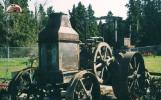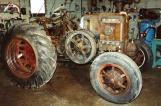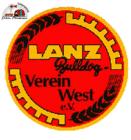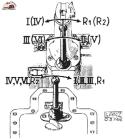1
Start of The Vintage Tractor CollectionThe coming of the Great War brought many changes to the Canadian West, as it did to nearly every part of the globe. The most immediate change was a drop in the number of farm labourers, as men left the farm either to enlist in the army or to obtain a factory job. This great population shift placed a huge burden on western farmers, since men who would ordinarily be working on the farm were now at war, and they still had to be fed. Thus, increased production demands were simultaneously accompanied by a dramatic reduction in the prairie workforce. Many farms were hard-pressed to keep up, with reduced manpower and a system that relied largely on draft animals for power. The sweeping sociological and cultural changes brought about by the war also meant that at war's end, fewer numbers of men were willing to return to the rugged, often low-paying existence of the farm labourer. Tractor companies often promoted the new gas tractor as a solution to this problem. The coming era of the gasoline tractor was ushered in, as many changes have been, by a great war. A bolstered wartime economy and the demand for increased production, coupled with government incentives, also made the purchase of a tractor feasible for many farmers who previously would not have had the financial resources.
3
1919 Rumely OilPull H"He cleared half the country with that thing!"
The neighbours knew a heavyweight when they saw one - the Rumely, at over 9000 lbs. (4100 kg) finished what it started. It cleared and plowed land at a constant 3 mph (4.8 kph), fueled by a mix of kerosene and water. Western farmers favoured this powerful and reliable tractor, even at $2400.
The 1919 model included new features such as paired cylinders, valves in the head and changes to the carburetor. Built with the throws in the crankshaft spaced 180° apart, these tractors could run with smaller crankshafts and flywheels, and better engine balance, than previous models. The last OilPull, with little change to this basic design, left the factory in 1931.
Donor: Frank Butcher
7
1928 Lanz BulldogDesigned for the land, and of massive construction, it is a true assistant of the farmer.
1920s ad
The Lanz Bulldog is the only tractor in our collection to be produced outside of North America. Manufactured in Mannheim, Germany, the Lanz looks different than other tractors - take a look at its square body lines, odd front, huge flywheel and strange-shaped exhaust.
Although touted as being able to run on any fuel, including buttermilk, we use diesel. Bringing this single cylinder lamp start engine to life also requires a blowtorch and an experienced driver. Originally bought by the Bower family, the tractor returned to Sunnybrook Farm Museum in 1991 after serving at least one other owner.
Donor: John Rich








